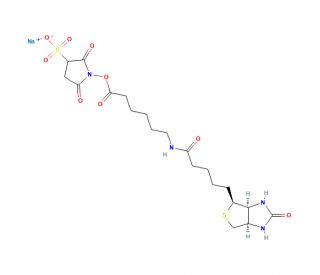

Biotinamidohexanoic acid 3-sulfo-N-hydroxysuccinimide ester sodium salt (CAS 127062-22-0)
QUICK LINKS
Biotinamidohexanoic acid 3-sulfo-N-hydroxysuccinimide ester sodium salt is involved in the synthesis of oligonucleotides for use in molecular biology research. It functions as a building block for the creation of modified DNA sequences, particularly at the 3′-end of the oligonucleotide chain. Biotinamidohexanoic acid 3-sulfo-N-hydroxysuccinimide ester sodium salt is utilized in solid-phase synthesis to introduce the N6-methyl-8-oxoadenosine modification at a specific position within the oligonucleotide sequence. The mechanism of action involves the activation of the 5′-hydroxyl group, allowing for the formation of a phosphodiester bond with the next nucleotide in the sequence. This modification can impact the stability, structure, and function of the resulting oligonucleotide, allowing to study the effects of specific modifications on DNA behavior and interactions. Biotinamidohexanoic acid 3-sulfo-N-hydroxysuccinimide ester sodium salt′s role in the synthesis process contributes to the generation of tailored DNA sequences for experimental use in various molecular biology applications.
Biotinamidohexanoic acid 3-sulfo-N-hydroxysuccinimide ester sodium salt (CAS 127062-22-0) References
- High sensitivity detection of protein molecules picked up on a probe of atomic force microscope based on the fluorescence detection by a total internal reflection fluorescence microscope. | Yamada, T., et al. 2004. FEBS Lett. 569: 59-64. PMID: 15225609
- Quantitative sandwich ELISA for the determination of lupine (Lupinus spp.) in foods. | Holden, L., et al. 2005. J Agric Food Chem. 53: 5866-71. PMID: 16028967
- Membrane proteinase 3 and its interactions within microdomains of neutrophil membranes. | Fridlich, R., et al. 2006. J Cell Biochem. 99: 117-25. PMID: 16598772
- Quantitative sandwich ELISA for the determination of tropomyosin from crustaceans in foods. | Werner, MT., et al. 2007. J Agric Food Chem. 55: 8025-32. PMID: 17713922
- Quantitative sandwich ELISA for the determination of fish in foods. | Faeste, CK. and Plassen, C. 2008. J Immunol Methods. 329: 45-55. PMID: 17980385
- Dendritic cell targeted chitosan nanoparticles for nasal DNA immunization against SARS CoV nucleocapsid protein. | Raghuwanshi, D., et al. 2012. Mol Pharm. 9: 946-56. PMID: 22356166
- A highly sensitive sandwich ELISA for the determination of glycomacropeptide to detect liquid whey in raw milk. | Chávez, NA., et al. 2012. Dairy Sci Technol. 92: 121-132. PMID: 22662290
- Melatonin Attenuates Aortic Endothelial Permeability and Arteriosclerosis in Streptozotocin-Induced Diabetic Rats: Possible Role of MLCK- and MLCP-Dependent MLC Phosphorylation. | Tang, ST., et al. 2016. J Cardiovasc Pharmacol Ther. 21: 82-92. PMID: 25944844
- Vitamin D (1,25(OH)2D3) induces α-1-antitrypsin synthesis by CD4+ T cells, which is required for 1,25(OH)2D3-driven IL-10. | Dimeloe, S., et al. 2019. J Steroid Biochem Mol Biol. 189: 1-9. PMID: 30690074
- Cryo-EM structure of the human TACAN in a closed state. | Chen, X., et al. 2022. Cell Rep. 38: 110445. PMID: 35235791
- The immunochemistry of sandwich ELISAs. II. A novel system prevents the denaturation of capture antibodies. | Suter, M. and Butler, JE. 1986. Immunol Lett. 13: 313-6. PMID: 3536729
- Biofunctionalisation of colloidal gold nanoparticles via polyelectrolytes assemblies | , et al. (2014). Colloid and Polymer Science. volume 292,: pages 33–50.
- Fibronectin-binding proteins of Clostridium perfringens recognize the III1-C fragment of fibronectin | and Tsutomu Yamasaki, Yasuo Hitsumoto, Seiichi Katayama, Yusaku Nogami. April 2010. Microbiology and Immunology. Volume54, Issue4: Pages 221-227.
Ordering Information
| Product Name | Catalog # | UNIT | Price | Qty | FAVORITES | |
Biotinamidohexanoic acid 3-sulfo-N-hydroxysuccinimide ester sodium salt, 10 mg | sc-275524 | 10 mg | $71.00 |
